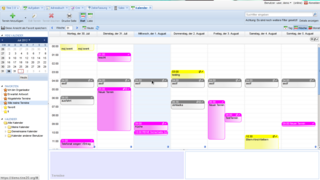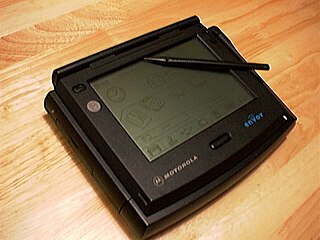Related Research Articles

A personal digital assistant (PDA), also known as a handheld PC, is a variety mobile device which functions as a personal information manager. PDAs have been mostly displaced by the widespread adoption of highly capable smartphones, in particular those based on iOS and Android.

Palm OS was a mobile operating system initially developed by Palm, Inc., for personal digital assistants (PDAs) in 1996. Palm OS was designed for ease of use with a touchscreen-based graphical user interface. It is provided with a suite of basic applications for personal information management. Later versions of the OS have been extended to support smartphones. Several other licensees have manufactured devices powered by Palm OS.

Palm was a line of personal digital assistants (PDAs) and mobile phones developed by California-based Palm, Inc., originally called Palm Computing, Inc. Palm devices are often remembered as "the first wildly popular handheld computers," responsible for ushering in the smartphone era.
Personal information management (PIM) is the study of the activities people perform in order to acquire or create, store, organize, maintain, retrieve, and use information items such as documents, web pages, and email messages for everyday use to complete tasks and fulfill a person's various roles.

A personal organizer, datebook, date log, daybook, day planner, personal analog assistant, book planner, year planner, or agenda, is a small book or binder that is designed to be portable. It usually contains a diary, calendar, address book, blank paper, and other sections. The organizer is a personal tool and may also include pages with useful information, such as maps and telephone codes. It is related to the separate desktop stationery items that have one or more of the same functions, such as appointment calendars, rolodexes, notebooks, and almanacs.
An application program is a computer program designed to carry out a specific task other than one relating to the operation of the computer itself, typically to be used by end-users. Word processors, media players, and accounting software are examples. The collective noun "application software" refers to all applications collectively. The other principal classifications of software are system software, relating to the operation of the computer, and utility software ("utilities").

Mobile computing is human–computer interaction in which a computer is expected to be transported during normal usage, which allows for the transmission of data, voice, and video. Mobile computing involves mobile communication, mobile hardware, and mobile software. Communication issues include ad hoc networks and infrastructure networks as well as communication properties, protocols, data formats, and concrete technologies. Hardware includes mobile devices or device components. Mobile software deals with the characteristics and requirements of mobile applications.

A mobile device is a computer small enough to hold and operate in the hand. Handheld computer devices will typically have a LCD or OLED flat screen interface, providing a touchscreen interface with digital buttons and keyboard or physical buttons along with a physical keyboard. Many such devices can connect to the Internet and connect with other devices such as car entertainment systems or headsets via Wi-Fi, Bluetooth, cellular networks or near field communication (NFC). Integrated cameras, the ability to place and receive voice and video telephone calls, video games, and Global Positioning System (GPS) capabilities are common. Power is typically provided by a lithium-ion battery. Mobile devices may run mobile operating systems that allow third-party applications to be installed and run.
Identity management (IdM), also known as identity and access management, is a framework of policies and technologies to ensure that the right users have the appropriate access to technology resources. IdM systems fall under the overarching umbrellas of IT security and data management. Identity and access management systems not only identify, authenticate, and control access for individuals who will be utilizing IT resources but also the hardware and applications employees need to access.

An electronic organizer is a small calculator-sized computer, often with an built-in diary application and other functions such as an address book and calendar, replacing paper-based personal organizers. It normally has a small alphanumeric keypad and an LCD screen of one, two, or three lines. The electronic diary or organizer was invented by Indian businessman Satyan Pitroda in 1975. He is regarded as one of the earliest pioneers of hand-held computing because of his invention of the Electronic Diary in 1975.
The term personal communicator has been used with several meanings. Around 1990 the next generation digital mobile phones were called digital personal communicators. Another definition, coined in 1991, is for a category of handheld devices that provide personal information manager functions and packet switched wireless data communications capabilities over wireless wide area networks such as cellular networks. These devices are now commonly referred to as smartphones.

A digital calendar is a collaborative or personal time management software with a calendar that can be used to keep track of planned events. The calendar can also contain an appointment book, address book or contact list. Common features of digital calendars are that users can:

The Motorola Envoy Personal Wireless Communicator was a personal digital assistant initially slated for release by Motorola in summer 1994 but delayed and then available for public sale in February 1995. It was built to run General Magic's Magic CAP operating system, and it combined wireless, telephone, and infrared modems in a single PDA package. Andy Rubin led development of the Motorola Envoy.
ThinkVantage Technologies is a set of system support utilities to reduce total cost of ownership of Lenovo brand desktop and laptop computers.

Mobile device forensics is a branch of digital forensics relating to recovery of digital evidence or data from a mobile device under forensically sound conditions. The phrase mobile device usually refers to mobile phones; however, it can also relate to any digital device that has both internal memory and communication ability, including PDA devices, GPS devices and tablet computers.
This outline is an overview of software and a topical guide in list form.

Mobile security, or mobile device security, is the protection of smartphones, tablets, and laptops from threats associated with wireless computing. It has become increasingly important in mobile computing. The security of personal and business information now stored on smartphones is of particular concern.
The following outline is provided as an overview of and topical guide to computing:
Pocket-sized computer describes the post-programmable calculator / pre-smartphone pocket-sized portable-office hardware devices that included the earlier DOS-based palmtops and subsequent Windows-CE handhelds, as well as a few other terms, primarily covering the 1980s through 2007.
References
- ↑ Jones, William; Teevan, Jaime, eds. (2007). Personal Information Management. WA: University of Washington Press. ISBN 978-0295987378.
- ↑ Jones, William (January 2008). "Personal information Management". Annual Review of Information Science and Technology. Association for Information Science & Technology. 41: 460–462. arXiv: 2107.03291 . doi:10.1002/aris.2007.1440410117 – via Wiley.
- ↑ Neyem, Andrés. "Sharing Information Resources in Mobile Ad-hoc Networks" (PDF). Department of Computer Science, Universidad de Chile.
- ↑ "The Return of the PDA". memex.org. Marketing Computers. February 1995.
- ↑ "History of the Personal Data Assistant (PDA)". BBC. H2G2. March 31, 2004. Retrieved January 18, 2014.